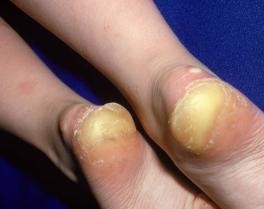Callus
Contents
Treatments Your Physician May Prescribe
|
|
|
||
|
|
|
|
|
|
|
|
|
|
|
|
|
|
|
|
Calluses can be thick, hard, and painful. |
|
Overview
A callus is a skin condition that occurs when the skin is subjected to pressure and forms a hard, thick surface to protect itself. Calluses are most commonly found on the soles of the feet and the toes but can be found anywhere that the skin is consistently under pressure, including the fingertips (particularly in musicians) and palms. A callus is similar to a corn, which is also a thick growth of skin on the feet or toes, but a corn tends to cover a smaller surface area and has a central core of softer skin, where a callus tends to be larger and without a central core. Calluses are not contagious, but other contagious conditions such as athlete's foot can mimic callus, and it is important to discuss any concerns with your doctor. There is no cure for calluses, but the regular use of certain creams and sometimes files or pumice stones can keep them under control.
Who's At Risk
Anyone of any age can get a callus except non-weight-bearing infants (though tight or ill-fitting shoes may give them blisters, it really takes pressure to get a corn or callus). Calluses are often caused by poorly fitting shoes or by standing, running, walking, or performing other repetitive exercises. Calluses are also more common in people with crooked toes.
Signs and Symptoms
Calluses are most frequently located on the feet and sometimes on the hands. They usually are located next to bony prominences.
Self-Care Guidelines
Avoidance of the repetitive forces causing calluses, such as altering shoe style, is the best method of prevention.
Gentle paring with an emery board or a pumice stone may help to decrease the thickened skin. A soft fabric, such as felt, should be applied after paring to protect the underlying skin, or shoe pads that go inside your shoes should be used to help relieve the pressure so foot calluses can heal.
When to Seek Medical Care
Calluses do not require medical intervention, but seek evaluation if they become bothersome. Diabetics should pay careful attention to their feet given the risk of development of diabetic ulcers on the feet.
Treatments Your Physician May Prescribe
Your physician may:
- Pare the callus with a scalpel.
- Prescribe a topical medication, such as urea, to help dissolve thickened skin.
- Refer the patient to a podiatrist, a health care provider specializing in foot care.







